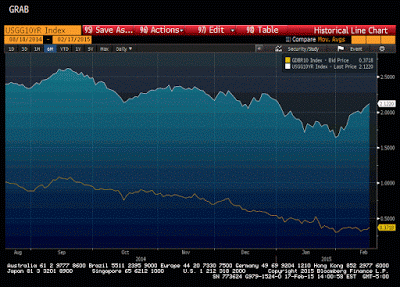This Great Graphic, created on Bloomberg, shows the US (white line) and German (yellow line) 10-year generic yields. Â

The US benchmark yield is at its highest level today since the first trading day of the year. It briefly traded at 2.15%. It is penetrating a downtrend today. It is found by drawing that drawn off the September high near 2.65%, and approached in early and late December. It comes in today near 2.11%. Recall that at the end of last month the 10-year yield was at 1.64%. The next chart-based resistance is seen near 2.20% then 2.30%.
The 10-year German bund yield set a record low at the start of this month just below 30 bp. It has not been above 40 bp this month. There have been two factors lending the bund support: Greek uncertainty and the anticipation of ECB purchases. We expect some kind of compromise that will keep Greece within EMU, which would take away some of the safe haven bid for bunds. The ECB purchases appear to have been discounted. German growth has surprised on the upside. Growth in the Q4 was a strong 0.7% (quarter-over-quarter) and sentiment surveys are recovering. The near-term risk is on the upside for bund yields.
The foreign exchange market has shown a clear bias toward bidding the euro higher on prospects of a settlement on Greece. The details seem somewhat less important than an agreement per se. Some observers have argued that the EMU would be stronger if Greece left. We do not see it that way. We think that its would negate the claim that monetary union is reversible. We are concerned that the costs of a Greek exit would be greater than keeping it in, which costs tax payers guarantees (and gives them lower interest rates and debt service savings).Â
In addition, we recognize that Syriza members of European parliament have been supportive of Russia. Many observers seem to forget that Greece is a NATO member and holds an important geo-strategic location. A loss of this “asset”, or even the neutralization of it, could be costly even though it does not fit neatly into econometric and balance sheet analysis. Â

